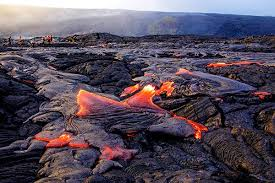The ongoing eruption of Hawaii’s Kilauea Volcano has opened up over twenty fissures in a residential neighborhood and resulting lava flows have destroyed dozens of homes and structures, but the threat to the Big Island extends beyond just the reach of emerging magma.
On Wednesday, a magnitude 4.4 earthquake rattled the volcano’s main caldera, damaging roads and buildings in Hawai`i Volcanoes National Park. Earlier, ash plumes led to an aviation red alert and raised the threat of acid rain and volcanic smog or “vog” from toxic sulfur dioxide gas that spews forth from the earth along with the lava.
And the compounding threats from Kilauea show little sign of slowing down. The lava column in the volcano’s main caldera has been dropping and the movement has been contributing to frequent earthquakes; cracks in nearby Highway 11 have also opened up.
“As deflation continues, strong earthquakes in the area around Kilauea Volcano’s summit are expected to continue and may become more frequent,” reads a statement from the USGS Hawaiian Volcano Observatory on Wednesday afternoon.
As the floor of the caldera drops, the risk of explosive, steam-driven interactions with the water table increases. This could launch large chunks of rock within about a half mile of the volcano summit and perhaps send smaller rocks flying for miles.
So far, though, the most dramatic activity from the summit has been a large plume of ash reaching up to two miles high that led authorities to increase the aviation alert to red.
On the ground, the ash fall and volcanic smog issuing forth have led to warnings to take precautions against exposure to sulfur dioxide, which can cause respiratory problems and irritate eyes. The National Weather Service issued a statement Wednesday on the possibility of hazardous air quality.
Meanwhile, lava is still a concern, too. Fountains of lava from re-animated fissures light up the evenings near the Leilani Estates subdivision in Puna while a flowing front of molten rock slowly continues to move downhill from fissure 17 toward the ocean along a path of steepest descent.
Forbes
 Lebanese Ministry of Information
Lebanese Ministry of Information



